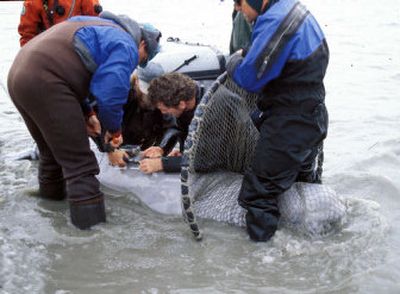Cook Inlet belugas may die out

ANCHORAGE, Alaska – The beluga whales swimming off Alaska’s largest city are at considerable risk of going extinct unless something changes, a federal study says.
The study by the National Marine Mammal Laboratory in Seattle says if the Cook Inlet belugas die out, another group of the white whales probably won’t come in to swim the silty waters off Anchorage.
“The population is discrete and unique with respect to the species, and if it should fail to survive, it is highly unlikely that Cook Inlet would be repopulated with belugas,” the study says.
The study found there is a 26 percent chance the Cook Inlet belugas will be extinct in 100 years and a 68 percent chance they’ll be gone in 300 years.
To make matters worse, it finds that the whales are becoming increasingly vulnerable to a catastrophic event because they are tending to gather in a restricted area in the upper Cook Inlet.
“At reduced numbers and with contraction of their range, this population is far more vulnerable to stranding, predation or disease,” the report says.
Alaska has five distinct geographic populations of beluga whales. Apart from about 300 Cook Inlet belugas, other groups are doing well with a total population estimate of between 35,000 and 40,000 animals. Others swim the western Alaska coastal waters of Bristol Bay, the eastern Bering Sea and the eastern Chukchi Sea; still others are located in the Beaufort Sea, north of Alaska and Canada.
The report is disheartening in light of efforts made in recent years to save the belugas. One of the problems is that scientists still do not know why numbers are declining.
It was thought that subsistence hunting, where about 70 whales were killed each year, was to blame. However, severe restrictions on subsistence hunting in place since 1999 have failed to turn the situation around.
“We thought it was entirely the result of the subsistence harvest, but the subsistence harvest may have been masking another problem,” said Rod Hobb, a biologist who helped prepare the extinction assessment.
New population numbers released Monday show a slight increase, but do little to change the overall picture, he said.
“The overall trend is downwards,” Hobb said.